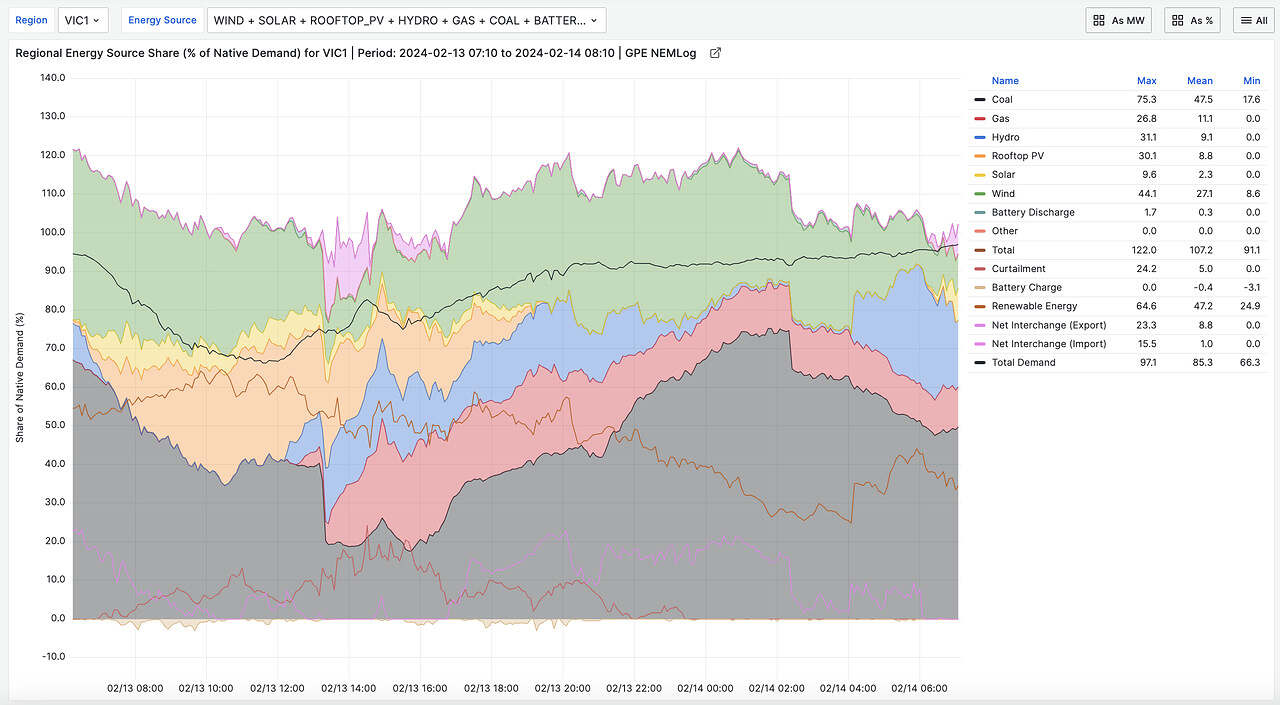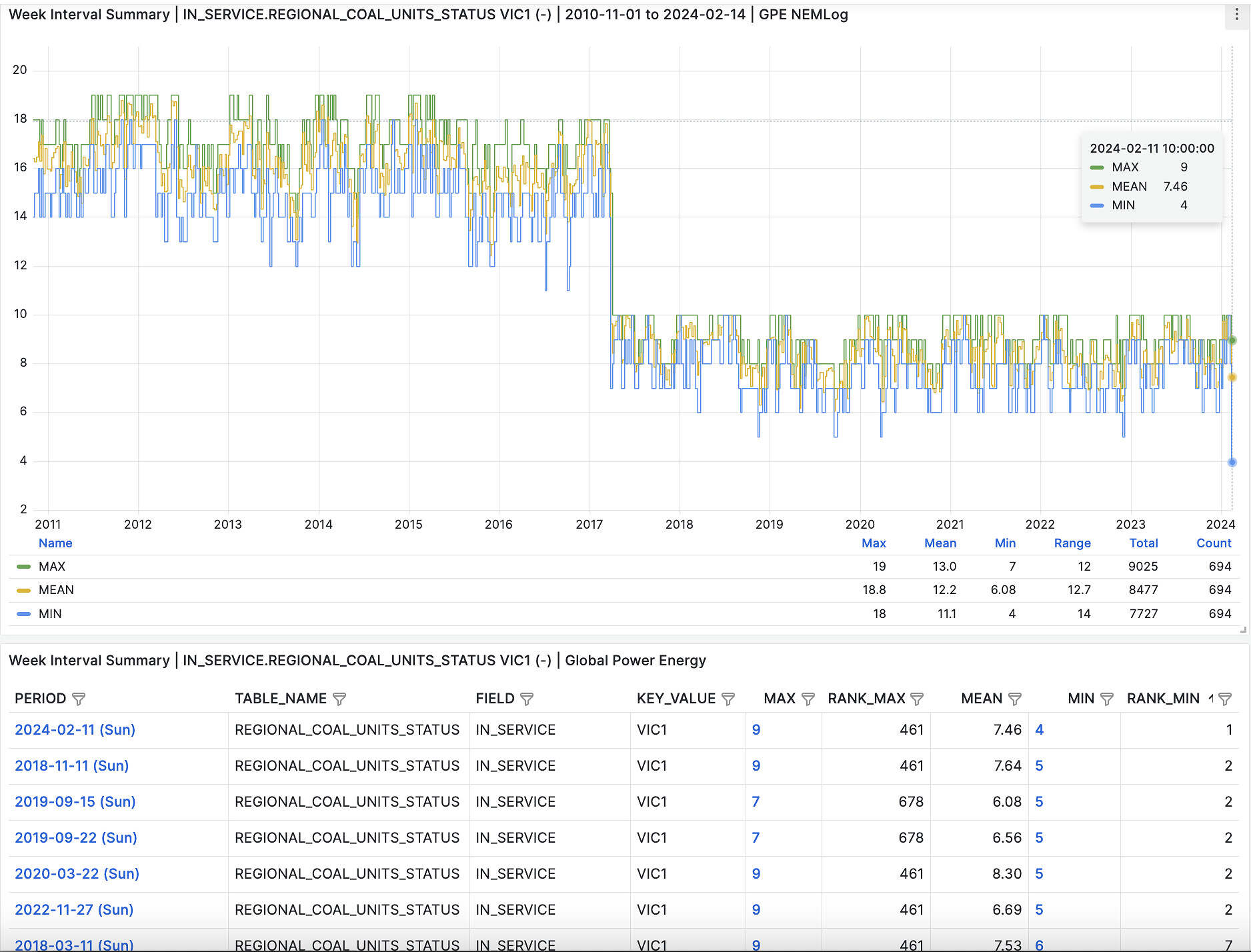On Tuesday, 13 February 2024, Victoria’s energy sector experienced a day of profound contrasts. The day commenced with the setting of new records in renewable energy, a testament to the region’s ongoing shift towards sustainable power sources.

Figure: Victorian Energy Source Contributions to Native Demand – Wed/Thu 13/14 Feb 2024 (GPE NEMLog-Lite)
These achievements were, however, swiftly overshadowed by a dramatic turn of events when severe weather led to the collapse of six 500 kV towers on the Moorabool to Sydenham Line(s). This incident triggered the tripping of all four in-service units at the Loy Yang A Brown Coal Fired Power Station, marking a first in Victorian history where the system operated with only four coal units online, down from the previous low of five.

Figure: Number of Victorian Coal Units In-Service – Weekly Maximum, Minimum and Mean from 01 Nov 2010 to 14 Feb 2023 (GPE NEMLog-Lite)
The Victorian Wind Farms at Yaloak South, Bulgana, Crowlands, Dundonnell 1, Dundonnell 2, Dundonnell 3, Elaine / Lal Lal, Kiata, Moorabool and Murra Warra also reduced their output to zero following the tower failures, some already out of service most likely due to strong winds.
Prior to these developments, renewable energy sources achieved significant milestones in Victoria, South Australia, and the NEM:
- Victorian Variable Renewable Energy (Vic VRE): At 11:35 hrs, a record high of 5,956.0 MW was achieved, which is an increase of 14.61 MW from the previous record of 5,941.3 MW set at 12:45 hrs on January 16, 2024. This represents a 0.25% increase.
- NEM Variable Renewable Energy (NEM VRE): At 12:00 hrs, NEM VRE reached a peak of 21,255.8 MW, up by 271.57 MW from the earlier record of 20,984.2 MW recorded at 12:50 hrs on December 6, 2023. This is a 1.29% increase.
- National Electricity Market Renewable Energy (NEM RE): NEM RE hit a maximum of 22,177.3 MW at 12:25 hrs. This was a significant increase of 494.0 MW from its previous high of 21,683.3 MW at 12:05 hrs on December 8, 2023, marking a 2.28% increase.
- Victorian Renewable Energy (Vic RE): The record for Vic RE was set at 6,310.9 MW at 12:25 hrs on February 13, 2024, up by 368.64 MW from the previous record of 5,942.3 MW at 12:45 hrs on January 16, 2024. This represents an increase of 6.20%.
- South Australian Rooftop Photovoltaic (SA Rooftop PV): On February 13, 2024, at 14:00 hrs, SA Rooftop PV reached 1,633.1 MW, surpassing the previous record of 1,607.4 MW set at 13:00 hrs on November 17, 2023, by 25.65 MW. This is an increase of 1.60%.
As a result of the towers collapsing and the Loy Yang A Unit trip, new Victorian minimum Coal Output and Share records were set:
- Victorian Brown Coal Output (Vic Brown Coal): A record low output for Victorian Brown Coal was recorded at 1,237.0 MW at 15:40 hrs on February 13, 2024. This was a decrease of 366.99 MW from the previous figure of 1,604.0 MW at 10:55 hrs on December 16, 2023, translating to a 22.87% reduction.
- Victorian Coal Share (Vic Coal Share): Also at 15:40 hrs, the share of coal in Victoria’s energy mix dropped to an all-time low of 17.6%, down 12.21% from the previous record of 29.8% recorded at 11:45 hrs on December 21, 2023. This represents a 40.97% decrease.
The events of the day, including the tower collapse and Loy Yang coal unit and other unit trips, highlight the critical need for a resilient and flexible energy grid. The lead graph depicting the Victorian Energy Supply for the day shows the impact of these incidents, particularly the tower collapse during the 13:10 hrs trading interval. Following the incident, gas played a crucial role in meeting Victoria’s energy demands, accompanied by necessary load shedding during certain periods. While one Loy Yang A unit briefly returned to service, it was later taken offline again, with only a second unit remaining in service.
This day serves as a stark reminder of the challenges posed by low probability, high impact events like severe weather, which caused extensive damage to transmission and distribution infrastructure, affecting countless customers. The loss of a number of units and in particular the consequent shutdown of the Loy Yang A power station, a critical element of Victoria’s energy infrastructure, led to soaring energy prices and has already sparked intense debates about grid vulnerability and current energy policies.
In witnessing Victoria operate with a record low number of coal units, we are observing a transformative era in energy production. This day underscores the evolving landscape of our energy systems and reinforces the importance of developing resilient and flexible grid solutions to adapt to these changing dynamics.
This article was originally published on LinkedIn, reproduced here with permission.
About our Guest Author
 |
Geoff Eldridge is a Principal Advisor at Global Power Energy. He is an experienced utilities analyst with over two decades of experience
You can find Geoff on LinkedIn. |


Be the first to comment on "Weathering the Storm: Victoria’s Record-Breaking Energy Day"